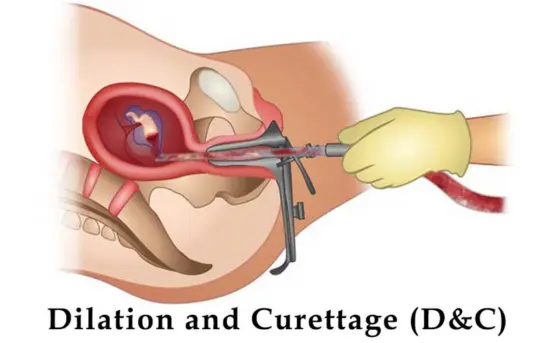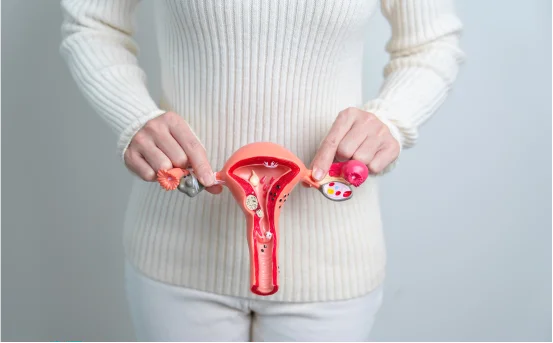Introduction
Dilation and Curettage is a surgical procedure performed by a gynecologist to remove tissue from the inside of the uterus. It involves two main steps:
- Dilation: The cervix is gradually opened using small rods or medications.
- Curettage: A surgical instrument called a curette is used to scrape or suction tissue from the uterine lining.
D&C is often performed in a hospital or outpatient setting and typically takes 10–20 minutes.
Understanding what is dilation and curettage surgery is essential for patients to grasp the importance and indications for this procedure. This knowledge helps in making informed decisions regarding their health.
Why is D&C Performed?
D&C is used for both diagnostic and therapeutic purposes.
Diagnostic Reasons:
- Abnormal Uterine Bleeding: To determine the cause of irregular or heavy periods.
- Postmenopausal Bleeding: To investigate bleeding after menopause.
- Suspected Cancer: To collect samples for endometrial or uterine cancer diagnosis.
- Infertility Investigations: To check for abnormalities in the uterine lining.
Therapeutic Reasons:
- Incomplete Miscarriage: To remove remaining tissue after a miscarriage.
- Molar Pregnancy: To clear abnormal tissue from the uterus.
- Postpartum Retention: To remove placental fragments after childbirth.
- Uterine Polyps or Fibroids: To remove small growths.
Symptoms That May Lead to a D&C
A D&C may be advised if you experience:
- Unexplained or heavy vaginal bleeding
- Bleeding between periods
- Bleeding after menopause
- Pelvic pain with bleeding
- Tissue passing during miscarriage
- Irregular menstruation not responding to medications
Preparation Before the Procedure
Before undergoing a D&C, your doctor will:
- Review your medical history
- Perform pelvic and ultrasound exams
- Order blood tests, if needed
- Discuss anesthesia options (local, general, or sedation)
You’ll be instructed to:
- Avoid eating or drinking for several hours before surgery.
- Arrange transportation post-procedure, as you may be drowsy.
How is Dilation and Curettage Done?
Step-by-step Procedure:
- Anesthesia is administered to ensure comfort.
- You’ll lie on your back with your legs supported (like during a pelvic exam).
- A speculum is inserted to open the vaginal canal.
- The cervix is gradually dilated using small instruments.
- A curette (sharp or suction type) is inserted into the uterus.
- The uterine lining or retained tissue is gently scraped or suctioned out.
- The removed material is sometimes sent to the lab for biopsy or testing.
- The patient is monitored during recovery.
The entire process usually takes less than 30 minutes.
Recovery After D&C Surgery
Immediate Recovery:
- Observation for a few hours after the procedure.
- Mild cramping or spotting for a few days.
- Fatigue and dizziness due to anesthesia.
At Home Care:
- Rest for 1–2 days.
- Avoid heavy lifting or vigorous exercise.
- No vaginal intercourse, tampons, or douching for at least 2 weeks.
- Use sanitary pads if bleeding occurs.
- Take pain relievers as prescribed.
Your period may return within 4–6 weeks, and fertility typically resumes quickly unless advised otherwise.
Risks and Complications
Though D&C is a relatively safe procedure, risks can include:
- Infection: Rare but possible if bacteria enter the uterus.
- Bleeding: Mild bleeding is common, but excessive bleeding needs attention.
- Uterine Perforation: An instrument may accidentally puncture the uterus.
- Asherman’s Syndrome: Scar tissue formation inside the uterus, affecting menstruation and fertility.
- Cervical Injury: If dilation damages the cervix.
- Reaction to Anesthesia
Prompt medical care should be sought if there is:
- Heavy bleeding (soaking a pad in an hour)
- Foul-smelling discharge
- Severe abdominal pain
- Fever or chills
When to Call a Doctor After D&C
Seek medical attention if you notice:
- High fever
- Excessive or prolonged bleeding
- Strong abdominal cramps not relieved by medication
- Fainting or dizziness
- Difficulty urinating
Benefits of Dilation and Curettage
- Quick and effective diagnostic tool
- Treats heavy or abnormal bleeding
- Resolves complications after miscarriage or delivery
- Helps remove benign growths or uterine tissue
- Provides biopsy samples for cancer detection
- Promotes faster healing in some uterine disorders
Emotional Impact of D&C
Especially when performed after a miscarriage or stillbirth, the emotional aftermath can be difficult. It’s important to:
- Speak with a counselor or therapist
- Give yourself time to grieve
- Communicate with your partner or family
- Join support groups if needed
Alternatives to D&C
Depending on the case, doctors may suggest alternatives:
- Medication: To manage incomplete miscarriage or bleeding
- Hysteroscopy: Visual examination of the uterus with camera-guided tools
- Endometrial biopsy: Less invasive than D&C, for sampling
- Watchful waiting: In some cases of early miscarriage
Always discuss options and preferences with your gynecologist.
Conclusion
Dilation and Curettage is a safe, commonly performed procedure used for diagnosis and treatment of various uterine conditions. While minor, it can be emotionally and physically significant, especially in the context of miscarriage. Proper preparation, understanding the purpose, and following aftercare guidelines can ease recovery and improve outcomes























